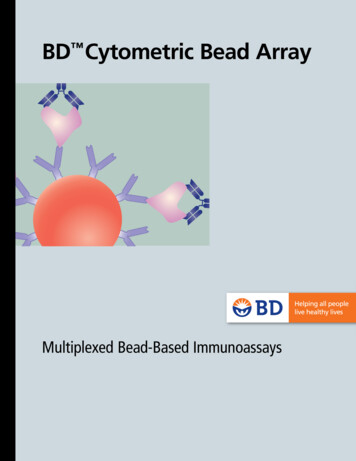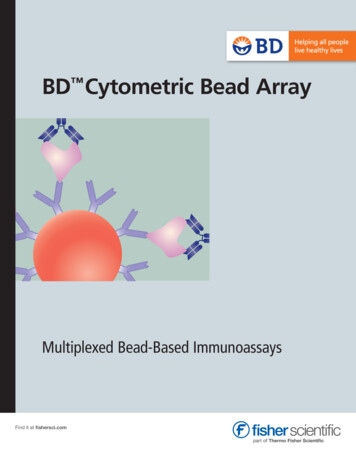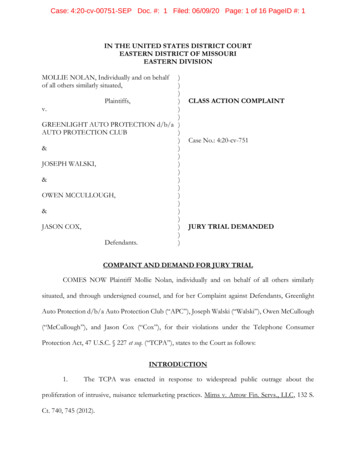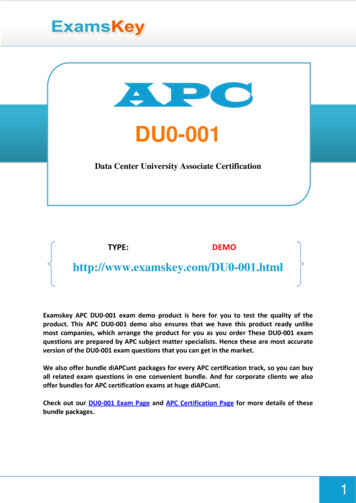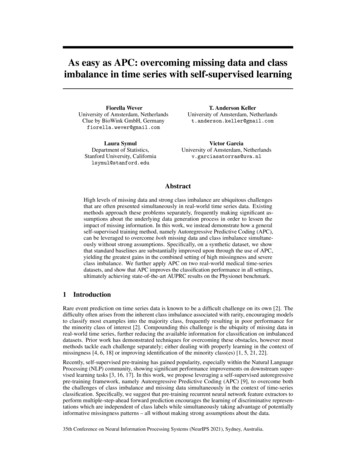
Transcription
As easy as APC: overcoming missing data and classimbalance in time series with self-supervised learningFiorella WeverUniversity of Amsterdam, NetherlandsClue by BioWink GmbH, Germanyfiorella.wever@gmail.comLaura SymulDepartment of Statistics,Stanford University, Californialsymul@stanford.eduT. Anderson KellerUniversity of Amsterdam, Netherlandst.anderson.keller@gmail.comVictor GarciaUniversity of Amsterdam, Netherlandsv.garciasatorras@uva.nlAbstractHigh levels of missing data and strong class imbalance are ubiquitous challengesthat are often presented simultaneously in real-world time series data. Existingmethods approach these problems separately, frequently making significant assumptions about the underlying data generation process in order to lessen theimpact of missing information. In this work, we instead demonstrate how a generalself-supervised training method, namely Autoregressive Predictive Coding (APC),can be leveraged to overcome both missing data and class imbalance simultaneously without strong assumptions. Specifically, on a synthetic dataset, we showthat standard baselines are substantially improved upon through the use of APC,yielding the greatest gains in the combined setting of high missingness and severeclass imbalance. We further apply APC on two real-world medical time-seriesdatasets, and show that APC improves the classification performance in all settings,ultimately achieving state-of-the-art AUPRC results on the Physionet benchmark.1IntroductionRare event prediction on time series data is known to be a difficult challenge on its own [2]. Thedifficulty often arises from the inherent class imbalance associated with rarity, encouraging modelsto classify most examples into the majority class, frequently resulting in poor performance forthe minority class of interest [2]. Compounding this challenge is the ubiquity of missing data inreal-world time series, further reducing the available information for classification on imbalanceddatasets. Prior work has demonstrated techniques for overcoming these obstacles, however mostmethods tackle each challenge separately; either dealing with properly learning in the context ofmissingness [4, 6, 18] or improving identification of the minority class(es) [1, 5, 21, 22].Recently, self-supervised pre-training has gained popularity, especially within the Natural LanguageProcessing (NLP) community, showing significant performance improvements on downstream supervised learning tasks [3, 16, 17]. In this work, we propose leveraging a self-supervised autoregressivepre-training framework, namely Autoregressive Predictive Coding (APC) [9], to overcome boththe challenges of class imbalance and missing data simultaneously in the context of time-seriesclassification. Specifically, we suggest that pre-training recurrent neural network feature extractors toperform multiple-step-ahead forward prediction encourages the learning of discriminative representations which are independent of class labels while simultaneously taking advantage of potentiallyinformative missingness patterns – all without making strong assumptions about the data.35th Conference on Neural Information Processing Systems (NeurIPS 2021), Sydney, Australia.
We validate our approach on a synthetic dataset generated with varying levels of missingness andclass imbalance, and find that APC substantially improves performance, especially in the severe classimbalance and high sparsity setting. Further, we apply APC on two real-world datasets, Physionet andClue, both containing missing values and class imbalance, and show that it improves the classificationresults in both cases, ultimately achieving state-of-the-art AUPRC scores on the Physionet benchmark.2Related workClass Imbalance Some of the most common methods for handling class imbalance consist of datare-sampling, such as under-sampling the majority class [1, 21] and over-sampling the minority class[5]. However, under-sampling can result in losing a significant amount of data, while over-samplingmethods, such as SMOTE [5], artificially increase the data set. Another widely adopted method isclass weights [22], which does not involve re-sampling, but provides an incentive to properly classifyminority class samples by giving them more weights in the loss function. Most related to this workare methods that approach class imbalance through unsupervised learning. One such method is thedual autoencoders features (DAF) [14], which uses two stacked autoencoders to learn different sets offeatures of the data in an imbalanced setting. It is shown to outperform traditional data re-samplingmethods, and suggests that leveraging unsupervised learning to obtain a set of relevant features couldbe a promising approach to deal with class imbalance. Our approach differs from those involvingautoencoders in that a time shifting factor n 1 encourages the model to learn forward predictivefeatures, and thus more global structure of the data, rather than only local structure [9].Missing Data Traditional methods for handling missing data often involve first filling in the missingvalues, and then applying predictive models on the imputed data [6]. Choosing a suitable imputationscheme is complex, dataset-specific and relies on a good amount of domain expertise. Furthermore,this results in a two-step process that prevents the prediction model from properly exploring themissingness patterns [6]. As shown in [6], such informative missingness may actually encode usefulinformation about the target labels. When it comes to state-of-the-art time series models, there areonly a handful that incorporate these missingness patterns when learning from the data. One exampleis the Bidirectional Recurrent Imputation for Time Series (BRITS) [4], which simultaneously imputesthe missing values and performs classification/regression within a joint neural graph. Another similarmethod is the GRU with trainable Decays (GRU-D) [6]. Both these methods take advantage of tworepresentations of informative missingness: masking and time interval [6]. Recently, two modelsbased on ordinary differential equations, the ODE-RNN and the Latent-ODE, have also shownpromising results on irregularly-sampled data [18]. However, the computational complexity of thesemodels is high, which [12] concluded led to not finding the optimal hyperparameters.Self-Supervised Pre-Training A special case of semi-supervised learning, called self-supervisedpre-training, aims to learn a good initialization point for the supervised setting instead of changingthe supervised learning objective [16]. Most models used for this purpose are based on autoencoders[19], while some of the most recent and promising methods are based on the idea of predictivecoding, such as Contrastive Predictive Coding (CPC) [15] and Autoregressive Predictive Coding(APC) [9]. Similar to CPC, APC learns from sequential data by trying to predict n 1 steps aheadof the current step [9]. However, while CPC learns from forward prediction in a contrastive way,APC does so in an autoregressive manner, and has shown to significantly outperform CPC on speechrecognition and phonetic classification tasks [8, 9]. Although APC pre-training has been previouslyproposed to improve supervised tasks, as far as we are concerned this is the first exploration of itsapplication to handle both missing values and class imbalance.3MethodsmAPC with MaskedMSE Given a length N sequence {xt }Nt 1 of observation vectors xt R , theAPC framework trains an autoregressive encoder Enc to sequentially reconstruct the observationat n 1 time steps ahead of the current step, for t 0 to N n (see Figure 4). Denoting ht thehidden state of the encoder at time t, with h0 0, the output of the network yt Rm is given as:ht Enc(ht 1 , xt )2yt Wht(1)
In prior work [9], the model was then trained to minimize the L1 distance between all predictionsPN nand ground truth (i.e L t 1 xt n yt 1 ). However, if applied directly in the highly-missingdata setting, we observe this loss encourages over-emphasis of missing predictions (analogous tothe challenges encountered with class imbalance). We thus propose a MaskedMSE loss to minimizereconstruction error over observed time steps only. Formally:PN-n2t 1 (xt n yt ) · mt nMaskedMSE({xt , yt }N) (2)PN nt 1t 1 mt nwhere the masking vector mt n {0, 1}m indicates which variables are missing at time step t n,and ensures that the encoder does not become biased towards missing values.Encoder Models & Missingness Handling To evaluate the impact of specific RNN encoderarchitectures within APC and how they handle missing values, we compare two different encoders:1) a baseline GRU [7], and 2) the state-of-the-art GRU-D [6] built to handle missingness. Since theGRU architecture does not inherently handle missing values, we add a binary “missingness” flagnext to each measurement xdt , showing 1 if the value is missing at that time-step and 0 otherwise.GRU-D builds on the GRU, but with trainable Decays and takes advantage of two representations ofinformative missingness patterns, masking and time interval, which replace the “missingness” flagsof the GRU. The time interval δtd R indicates how long it has been for each variable d since its lastobservation, and is used to exponentially decay missing input variables and hidden states from theirlast value toward their empirical mean. Representations learned in the self-supervised setting withAPC are leveraged by using ht , the output of the last layer of the APC encoder (GRU/GRU-D), asinput for the classifier, trained with a cross-entropy loss.4ExperimentsDatasets We first evaluate our method on a synthetic dataset for which we control the level ofmissing values, as well as the level of class imbalance. This provides insights on the potential gains inperformance provided by APC in handling class imbalance and data missingness both independentlyand in combination. The synthetic dataset consists of time-series of two variables, one continuous(noisy sine curve) and one binary (random Bernoulli). The output is a non-linear function of thesine curve frequency and of the Bernoulli variable probability (See Appendix for details). We alsoexperiment on two real-world datasets: a benchmark dataset from the Physionet Challenge 2012 [11],and time series data from the menstrual cycle tracking app Clue [10]. Clue samples contain 70.29%missing values on average with 92% majority class, while Physionet contains 79.75% missing with86% majority class. Our code is available at https://github.com/anonSSLneurips/APC.Performance Evaluation For binary classification tasks (such as our synthetic dataset and Physionet), we choose to report AUPRC score as it more accurately shows how well the model is handlingthe minority class. For multi-class classification in the class imbalance setting (as with Clue), theweighted F1 score is the most common metric [20]. We also introduce the weighted F1 minorityscore (defined in appendix) to highlight the performances on the minority classes. Similar to priorwork on Physionet [12], we use 60 % of the dataset as our training data, 20 % as validation and 20 %as the test set, preserving the class distribution in each set. Evaluation on the test set was performedusing the model with the best performance on the validation set. Results are reported as the mean std. of the performances on the test set over 3 independent runs.Baselines For Physionet, we compare our results to the state-of-the art results for this benchmarkdataset, achieved with GRU-D [12]. We note our reimplementation does not reach the same performance as the published model, and address the main differences between the implementations in theappendix. Despite these differences, our model still surpasses the best published AUPRC score forPhysionet, as can be seen in Table 1. For Clue, given the proprietary nature of the dataset, we compareour results to a naive majority class baseline as well as ablations of our own model, observing APCaugmented models again perform best. We additionally compare the performance of APC timeshift factor n 1 to an autoencoder (n 0), observing optimal performance with n 1, validatingthe use of APC compared to standard auto-encoding. As additional baselines, we compare ourAPC implementations to several different types of imputation methods (GRU-Mean, GRU-Forward,GRU-Simple) [12] in combination with class imbalance methods such as class weights.3
Figure 1: Classification results on synthetic dataset. GRU and GRU-D are implemented using classweights, while the APC implementations do not use class weights. The lines in the figure show themedian, and the borders of the shaded region indicate the min and max (extremes) of the results.Results: Synthetic Data The results on our simulated dataset (Figure 1) show that applying APCimproves the classification performance independently in the class imbalance setting and in thesparsity setting, as well as when dealing with both in conjunction. Figure 1 highlights the medianand min and max (extremes) of the results. We see that APC improves performance substantiallyand significantly, especially in the high sparsity and severe class imbalance setting, improving themean AUPRC score of the baseline GRU from 6.61% to 66.42% (appendix Table 6) when GRU-Dand APC are applied in combination. Interestingly, we see that adding APC to a baseline GRU aloneappears sufficient to achieve optimal performance, improving over GRU-D-APC in the majority ofsettings (see Table 6). As shown next, these results are further supported by the performance of APCmodels on real-world data, ultimately lending strength to the idea that self-supervised learning isa feasible solution to both class imbalance and data missingness on its own without the need fordata-dependent assumptions.Results: Real-World Data Applied to real-world data, we find that APC with time shift factor n 1 performs best on both Physionet (Table 1) and Clue (appendix Tables 8 & 9), outperformingstandard autoencoding (n 0), indicating that the features learned through forward prediction aremore relevant than those learned by reconstructing the input directly. In Table 1, we show thatthe GRU-APC, which tackles both class imbalance and missing data simultaneously, outperformsbaselines that use a combination of independent methods. We include four literature baselines toshowcase the variability in existing results, and observe that our models leveraging APC outperformall of them, achieving state-of-the-art AUPRC scores and competitive AUROC scores without needingclass weights. Further, in Table 2, we show a continuation of this trend, observing that GRU-APCalso improves the results on Clue compared to baselines, although in this case oversampling classweights are also needed likely due to the more severe imbalance. Interestingly, we see a differenttrend in performance of the imputation methods on both datasets, indicating that these methodsimpose assumptions that are dataset-specific. One major advantage of APC is that it does not imposesuch strong assumptions on what the missing values should be, yet consistently achieves competitiveperformance.5DiscussionIn this work we demonstrate self-supervised APC pre-training as a promising method to dealwith both severe class imbalance and high levels of missing data in the context of time-seriesclassification. Although APC pre-training is not a drastically novel method, the proposed applicationto handle missing values and class imbalance has not been significantly explored before, makingour contribution a grounded exploration of this idea. We show empirically on synthetic and realworld data that representations learned by APC pre-training are superior to standard auto-encodingbaselines, and additionally perform on-par or better than existing methods built explicitly to handlethe challenges of imbalance and missingness. We note that this work is inherently preliminary andlimited in scope, however we believe it provides a grounded foundation for further exploration of thebenefits of self-supervised learning in the context of missing data and class imbalance.4
Table 1: Comparisons on Physionet 2012 mortalitytask. OS oversampling, CW class weights.ModelGRU-D [6]GRU-D [12]GRU-D [4]BRITS [4]GRUGRU-MeanGRU-ForwardGRU-SimpleGRU-DGRU-APC (n 0)GRU-D - APC (n 0)GRU-APC (n 1)GRU-D - APC (n 1)GRU-APC (n 1)GRU-D - APC (n 1)Class WnonenoneCWCW84.24 1.286.3 0.383.4 0.285.0 0.285.4 0.484.6 0.284.3 1.085.5 0.185.5 0.384.2 0.385.0 0.386.0 0.585.2 0.985.9 0.385.3 0.153.7 0.951.4 0.950.3 0.752.0 1.453.8 0.253.1 0.450.4 0.353.3 0.354.1 1.054.1 2.353.5 0.555.1 0.9Table 2: Comparisons on Clue classification task.Modelnaive -APC (n 1)GRU-D - APC (n 1)weightedF1weightedF1 minority87.4790.3 0.788.4 0.587.5 0.287.8 0.387.5 0.390.7 0.190.3 0.022.3 7.222.1 1.822.1 0.522.2 0.422.5 0.725.7 1.127.3 0.5References[1] Barandela, R., Sánchez, J. S., Garcıa, V., & Rangel, E. (2003). Strategies for learning in class imbalanceproblems. Pattern Recognition, 36(3), 849-851.[2] Branco, P., Torgo, L., & Ribeiro, R. (2015). A survey of predictive modelling under imbalanced distributions.arXiv preprint arXiv:1505.01658.[3] Brown, T. B., Mann, B., Ryder, N., Subbiah, M., Kaplan, J., Dhariwal, P., . & Amodei, D. (2020). Languagemodels are few-shot learners. arXiv preprint arXiv:2005.14165.[4] Cao, W., Wang, D., Li, J., Zhou, H., Li, L., & Li, Y. (2018). Brits: Bidirectional recurrent imputation fortime series. arXiv preprint arXiv:1805.10572.[5] Chawla, N. V., Bowyer, K. W., Hall, L. O., & Kegelmeyer, W. P. (2002). SMOTE: synthetic minorityover-sampling technique. Journal of artificial intelligence research, 16, 321-357.[6] Che, Z., Purushotham, S., Cho, K., Sontag, D., & Liu, Y. (2018). Recurrent neural networks for multivariatetime series with missing values. Scientific reports, 8(1), 1-12.[7] Cho, K., Van Merriënboer, B., Gulcehre, C., Bahdanau, D., Bougares, F., Schwenk, H., & Bengio, Y. (2014).Learning phrase representations using RNN encoder-decoder for statistical machine translation. arXiv preprintarXiv:1406.1078.[8] Chung, Y. A., & Glass, J. (2020, May). Generative pre-training for speech with autoregressive predictivecoding. In ICASSP 2020-2020 IEEE International Conference on Acoustics, Speech and Signal Processing(ICASSP) (pp. 3497-3501). IEEE.[9] Chung, Y. A., Hsu, W. N., Tang, H., & Glass, J. (2019). An unsupervised autoregressive model for speechrepresentation learning. arXiv preprint arXiv:1904.03240.[10] Clue by BioWink GmbH (2020).URLhttps://helloclue.com/. Adalbertstraße 7-8, 10999 Berlin,Germany.[11] Goldberger, A. L., Amaral, L. A., Glass, L., Hausdorff, J. M., Ivanov, P. C., Mark, R. G., . & Stanley, H.E. (2000). PhysioBank, PhysioToolkit, and PhysioNet: components of a new research resource for complexphysiologic signals. circulation, 101(23), e215-e220.[12] Horn, M., Moor, M., Bock, C., Rieck, B., & Borgwardt, K. (2020, November). Set functions for time series.In International Conference on Machine Learning (pp. 4353-4363). PMLR.[13] Mikalsen, K. Ø., Soguero-Ruiz, C., Bianchi, F. M., Revhaug, A., & Jenssen, R. (2021). Time series clusterkernels to exploit informative missingness and incomplete label information. Pattern Recognition, 115, 107896.[14] Ng, W. W., Zeng, G., Zhang, J., Yeung, D. S., & Pedrycz, W. (2016). Dual autoencoders features forimbalance classification problem. Pattern Recognition, 60, 875-889.[15] Oord, A. V. D., Li, Y., & Vinyals, O. (2018). Representation learning with contrastive predictive coding.arXiv preprint arXiv:1807.03748.[16] Radford, A., Narasimhan, K., Salimans, T., & Sutskever, I. (2018). Improving language understanding bygenerative pre-training.5
[17] Radford, A., Wu, J., Child, R., Luan, D., Amodei, D., & Sutskever, I. (2019). Language models areunsupervised multitask learners. OpenAI blog, 1(8), 9.[18] Rubanova, Y., Chen, R. T., & Duvenaud, D. (2019). Latent odes for irregularly-sampled time series. arXivpreprint arXiv:1907.03907.[19] Sagheer, A., & Kotb, M. (2019). Unsupervised pre-training of a deep LSTM-based stacked autoencoder formultivariate time series forecasting problems. Scientific reports, 9(1), 1-16.[20] Sokolova, M., & Lapalme, G. (2009). A systematic analysis of performance measures for classificationtasks. Information processing & management, 45(4), 427-437.[21] Yen, S. J., & Lee, Y. S. (2009). Cluster-based under-sampling approaches for imbalanced data distributions.Expert Systems with Applications, 36(3), 5718-5727.[22] Zhu, M., Xia, J., Jin, X., Yan, M., Cai, G., Yan, J., & Ning, G. (2018). Class weights random forestalgorithm for processing class imbalanced medical data. IEEE Access, 6, 4641-4652.6
AA.1AppendixDatasetsSynthetic datasetThe synthetic dataset is generated as N two-variable time series of length T . Here N 2000 andT 100. The first variable, x, is a continuous variable simulated asxn (t) 1 on cos(2πt) Pnwith N (0, σ) and where on , a random offset, is uniformly sampled from [0, 1] and Pn , the cosineperiod, is uniformly sampled from [Pmin , Pmax ]. Here, we chose Pmin 5 and Pmax 20. Thesecond variable, b, is simulated as a Bernoulli variable with a probability pn , which is randomlysampled in [0, 1] for each time series n.The output yn is built as a combination of x’s period (Pn ) and b’s probability (pn ). Specifically,yn (Pn 0.5)(pn 0.5).PhysionetFor the benchmark dataset from the Physionet Challenge 2012 [11], the classification task is to predictwhether an ICU patient will survive or die during their stay at the hospital. Physionet samples contain79.75 % missing values on average [62.61, 99.94]. Physionet is a binary classification benchmark,where the majority class makes up 86% of all the samples.ClueFor the Clue dataset, we seek to predict the discontinuation of birth control methods over time.Clue samples contain 70.29 % missing values on average [6.06, 81.45]. Since we’re dealing with 4different output classes (see Table 4), Clue requires multi class classification, where the majorityclass makes up 92 % of all the samples.A.2Class imbalanceTable 3: Physionet: Class distribution.O UTPUT L ABELP ERCENTAGE % OF TOTALS URVIVORD IED IN - HOSPITAL85.7614.24Table 4: Clue: Class distributionO UTPUT L ABELP ERCENTAGE % OF TOTALONOFFOTHER- HORMONALOTHER- NON - HORMONAL91.524.882.221.387
A.3Missing valuesClue contains 70.29 % missing values on average ranging from 6.06 % to 81.45 %, while Physionetcontains 79.75 % missing values on average ranging from 62.61 % to 99.94 %.Figure 2: Physionet: Examples of time series for two different ICU patients with different frequenciesof observations. On the left, we have a time series with a high frequency of observations. On theright is an example of a patient who is barely observed.Figure 3: Clue: Example of the time series of the 3 input cycles for a user that tracks with lowfrequency (left), and a user that tracks with high frequency (right).8
A.4Clue’s Empirical MeanWhile Physionet has one mean per variable, we implement a multi-dimensional mean for the Cluedataset, with each variable having a different mean for each day of the cycle.A.5Time scalesIn the Physionet dataset, the measurements are observed at irregular time steps at a minute-by-minuteresolution. For the GRU model, we aggregate the measurements to a 1 hour resolution, similarto what had been done in previous work on this dataset [6]. However, for the GRU-D model weaggregate the measurements to a 1-decimal time resolution (e.g. 2.6 hours) as in the original GRU-Dpaper [6]. This allows the model to learn with more detail the time interval since a variable was lastobserved.A.6APC model architectureFigure 4: Autoregressive Predictive Coding (APC): input sequence {xt }Nt 1 is encoded (e.g. withan RNN) at each time step to a hidden state ht . A matrix W then transforms the hidden states to anoutput sequence {y}Nt 1 of the same dimension as xt .A.7Frozen vs fine-tuned APC weightsTo leverage the representations that were learned in the self-supervised setting with APC, we take theoutput of the last layer of the GRU/GRU-D encoder in the APC as the extracted representations, i.e.Enc(x) h, then implement the classifier on top of them. In the semi-supervised setting, we usedtwo scenarios, consecutively:1. frozen: the weights of the pre-trained encoder are kept frozen and only the classificationmodel is optimized.2. fine-tuned: APC’s encoder and the classifier are trained end-to-end so that the learnedrepresentations are better suited to the final classification task.9
Figure 5: Step 1: The APC is pre-trained by optimizing the autoregressive lossFigure 6: Step 2: The APC encoder weights are frozen & the classifier is trained by optimizing thecross-entropy loss.Figure 7: Step 3: Both the encoder & the classifier are trained end-to-end, using the pre-trainedencoder & pre-trained classifier weights.10
A.8Comparison to Referenced PublicationsTo our knowledge, the most competitive and state-of-the-art results that have been achieved to date onthe Physionet in-hospital mortality task are by Horn et al. (2019), with their GRU-D and Transformerimplementations attaining AUPRC scores of 53.7 0.9, and 52.8 2.2, respectively [12].Consequently, we set out to implement the GRU-D similar to their implementation, so that ourmethods are directly comparable. However, we noticed that some architectural decisions taken in [12]were leading to lower performance scores overall compared to our initial implementation. Therefore,we decided to keep to our initial implementation. For full disclosure, the main differences betweenthe two implementations are: When processing the static variables, [12] compute the initial state of the RNN based onthese static variables. Contrary to their implementation, our RNN does not handle the staticvariables. Instead, the static variables are concatenated with the final hidden states learnedby the RNN which are then input directly into the classifier. To handle the class imbalance, they oversample the minority class, while we implement theGRU-D using class weights. Our dataset partition (train, validation, and test splits) might be different from theirs, whichcould be another source of potential variations in results.A.9Evaluation MetricsBinary ClassificationThe AUROC score is given by the following formula:AUROC TPrate TNrate1 TPrate FPrate 22(3)where the TPrate , FPrate , and the TNrate are defined as:true positive rate (recall) true positivetrue positive false negative(4)false positive rate false positivefalse positive true negative(5)true negative rate true negativetrue negative false positive(6)However, when dealing with imbalanced classification, ROC curves may give an extremely optimistic view of the performance [2], and in these cases the precision-recall curves (PR curves) arerecommended as the more appropriate metric. The PR curve shows a plot of the recall vs. precisionfor different probability tresholds. The recall, also known as the true positive rate or sensitivity, isdisplayed in Equation 4, and the precision is defined as:precision true positivetrue positive false positive(7)Both the precision and recall are mostly focused on the positive class (minority class) and are notconcerned about the true negatives (majority class). The Area Under this Precision-Cecall Curve score(AUPRC) is therefore mostly a representation of how well the model is handling the minority class.Since the AUPRC is arguably the most appropriate metric in the case of imbalanced classification,we focus on this performance metric for the binary classification task.11
Multiclass ClassificationWe evaluate the performance of the multi-class classifier with the F1-score [20], which is theharmonic mean of the precision and recall:F1 2 ·precision · recallprecision recall(8)Since our test set is class imbalanced, we do not want to give equal weights to each class, but insteadwe want to calculate a weighted average F1-score:#Class 1#totalx F1Class 1 #Class 2#total#Class 3#totalx F1Class 2 x F1Class 3 #Class 4#totalx F1Class 4(9)Furthermore, to highlight the performances on the minority classes, we define the weighted F1minority:#Class 2#total minorityA.10x F1Class 2 #Class 3#total minorityx F1Class 3 #Class 4#total minorityx F1Class 4Data imputation baselinesGRU-Mean:GRU-Forward:xdt mdt xdt (1 mdt )x̃d(10)xdt mdt xdt (1 mdt )xdt0(11)GRU-Simple:(n)xtA.11(n)(n)(n) [xt ; mt ; δt ](12)Oversampling & class weightsBecause the Clue dataset contains a more severe class imbalance compared to Physionet, we proposeanother method specifically for Clue, which combines both oversampling [5] and using class weights.In this case, we oversample the minority class to 12% and then use class weights on the oversampledclass frequency.12
A.12HyperparametersTable 5: Final hyperparameters used for each model on each dataset, after performing theticPhysionetClueGRUGRU-DGRU - APCGRU-D - APClearning ratebatch sizehidden unitsdropoutrecurrent dropoutepochslearning ratebatch sizehidden unitsdropoutrecurrent dropoutepochslearning rate - step 1learning rate - step 2 & 3batch sizehidden unitsdropoutrecurrent dropoutepochslearning rate - step 1learning rate - step 2 & 3batch sizehidden unitsdropoutrecurrent dropoutepochs - step 1epochs - step 2 & 002500.10.05050
A.13ResultsTab
class imbalance. We further apply APC on two real-world medical time-series datasets, and show that APC improves the classification performance in all settings, ultimately achieving state-of-the-art AUPRC results on the Physionet benchmark. 1 Introduction Rare event prediction on time series data is known to be a difficult challenge on its .

